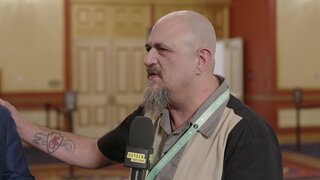The Vampire of Sacramento: The Unspeakable Crimes of Serial Killer Cannibal Richard Chase
Richard Chase believed killing six people and consuming their blood would cure him of his perceived physical conditions. Despite multiple diagnoses of paranoid schizophrenia, psychiatrists deemed him fit to stand trial.
Richard Trenton Chase began killing animals at a young age, and despite several attempts to get him help for his mental health, his crimes would escalate homicidal acts so depraved that Oxygen.com had to withhold many of the details. Later, FBI agents — including famed criminal profiler Robert Ressler — would note that Chase’s delusions were rooted in nonsensical theories about U.F.O.s, the mafia, and the C.I.A., and that his ideas were “very typical of a paranoid psychotic personality,” according to the FBI.
Chase would defend his killing six people during a one-month period in the late 1970s, claiming he had to drink the victims’ blood to cure him of a “condition” in which he believed U.F.O. “death rays” diminished his blood supply. The acts, which also included cannibalism, mutilation, and necrophilia, earned Chase the moniker “The Vampire of Sacramento” and others like it.
Here’s what to know:
Who did Richard Chase kill?
On December 29, 1977, 51-year-old engineer Ambrose Griffin was shot in the chest during a drive-by while helping his wife carry groceries from their vehicle, according to The Sacramento News & Review. The seemingly random crime provided few leads to detectives until January 23, 1978, when then-27-year-old Chase broke into the Sacramento home of 22-year-old Teresa Wallin and killed her in gruesome fashion.
Wallin was three months pregnant with a son that she and her husband, David Wallin, planned to name “Dane,” the husband told The U.S. Sun in January 2022. When Mr. Wallin returned from a work trip, he found his wife with her torso cut open, disemboweled, and with her undergarments ripped away.
"I had no idea where I was, or who or what I had seen," David told The Sun. "It was just beyond all comprehension.”
Chase claimed to have approached the expectant mother as she readied to take out the trash, shooting her three times and stabbing her with a butcher knife, according to the Sacramento outlet. He then raped the cadaver, cut off her nipples, drank her blood, and smeared her insides on the wall.
Chase later told authorities he would go around neighborhoods and see which doors were locked, perceiving any unlocked door as an invitation. Such was the case for Teresa Wallin and the quadruple murder Chase committed four days later.
On Jan. 27, 1978, Chase entered the Merrywood Drive residence of Evelyn Miroth, 38, and her son, Jason, 6, according to archived police records published by the FBI. At the time, Daniel Meredith, 50, a longtime friend of the family and Jason’s godfather, was also at the home as Miroth babysat her 22-month-old nephew, David Ferreira.
Contemporaneous reports said the murders were the work of “an apparent psychopath.”
The adults were both fatally shot in the head before the killer defiled Miroth’s corpse, according to The Sacramento News & Review. Like Wallin, she was found in her bedroom, disemboweled, and the object of necrophilia.
Jason also died of multiple gunshot wounds to the head, though his body was not mutilated. The toddler, however, was missing from the residence, prompting a massive search for Ferreira.
On March 24, 1978, the boy’s mutilated body was discovered in a cardboard box in a vacant lot, according to a 2005 report by Radford University.
Chase was categorized as a disorganized serial killer, doing little to nothing to cover up his grotesque acts.
Richard Chase’s severe mental health issues
Richard Chase’s violent crimes dated back to when he was 10, beginning when he started torturing and killing cats, according to the Radford University report. Several outlets, including The Sacramento News & Review, cited that, even as a boy, Chase exhibited signs of the Macdonald Triad (animal torture, arson, and bedwetting past age 5), acts sometimes linked to sociopathy or psychopathy.
The Sacramento news outlet reported his parents allegedly abused him as a child.
Chase’s teenage and early adult years were rife with drug use and bizarre behavior. He reportedly used copious amounts of L.S.D., marijuana, and alcohol. According to profilers, his parents took him to see psychiatrists at age 12, and again at 18 for chronic impotence.
Chase's living situation often changed, bouncing between roommates, his parents, and a Los Angeles-based grandmother, and he frequently visited hospitals for imagined illnesses. However, in 1973, a neurologist concluded Chase “had a psychiatric disturbance of major proportions,” according to the Radford University report. The patient reported that someone had stolen his pulmonary vein, and his blood flow had stopped.
Other hallucinations over the years included his being reincarnated as one of the gangsters tied to legendary outlaw Jesse James. According to the News & Review, he shaved his head, hoping to catch the cranial bones he believed moved around in his head.
In 1975, Chase became ill after injecting rabbit’s blood into his veins — part of the delusions he held about his circulatory system, per the Sacramento outlet. While in care with mental health services, housekeepers regularly found dead animals near his quarters, per the Radford report.
Twice, he was diagnosed with paranoid schizophrenia, and in the same year of the murders, his then-divorced parents were granted a conservatorship, per the Radford report. Some, at the time, believed Chase was exaggerating his claims that he would steal and consume rabbits, cats, and dogs raw and drink their blood.
According to the News & Review, Chase used to mix rabbit intestines and Coca-Cola in a blender for consumption. His mother also reported seeing her son rip into a deceased cat, covering himself with blood.
Evidence of the horrific crimes was obvious when authorities arrested Chase following the six murders. There, parts of his victims — including Ferreira’s brain — were found inside the killer’s apartment and refrigerator.
How did law enforcement catch Richard Chase?
Following the Miroth murders and kidnapping, law enforcement issued an alert for a man in an orange parka. Nancy Holder, one of Chase’s former high school classmates, reported running into the suspect at a shopping center in Sacramento, according to The Sacramento News & Review. Chase was reportedly aware that one of Holder’s former boyfriends died in a motorcycle accident, asking Holder, “Were you on the motorcycle when Kurt was killed?”
Holder hardly recognized Chase, and realizing he wore an orange parka like that of the murder suspect, Holder contacted authorities.
Police soon arrested Chase at his apartment, and a mountain of physical evidence — including the .22 caliber gun registered in Chase’s name used to kill the victims — would tie him to the unsolved murders.
On May 28, 1979, Chase was found guilty of all six murders and sentenced to death, according to the Radford report. Despite his extensive history of mental illness, two psychiatrists deemed him fit to stand trial.
FBI psychological profilers had this, in part, to say after assessing Chase in San Quentin: “Chase advised that he is considering an appeal because of the fact that under California law, it is justifiable homicide when a person kills to save his own life and that in the case of his murders, Chase was killing to obtain blood, which was necessary to sustain his life — Thus, justifiable homicide,” according to the FBI.
Where is Richard Chase now?
Richard Chase was found dead in his cell on San Quentin’s infamous death row on Dec. 26, 1980, according to the News & Review. It was determined he’d died from overdosing on his antidepressants, having stockpiled them over some time.
He was 30 years old.
According to the Sacramento outlet, Ressler included his interviews with Chase in his bestselling book, Whoever Fights Monsters. Chase’s crimes remain the subject of case studies in disorganized murders.











































